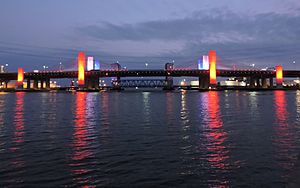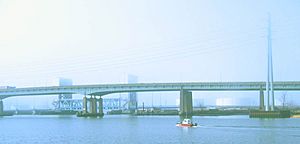Pearl Harbor Memorial Bridge (Connecticut) facts for kids
Quick facts for kids Pearl Harbor Memorial Bridge |
|
|---|---|

The Pearl Harbor Memorial Bridge, locally known as the Q Bridge, crosses over the Quinnipiac River.
|
|
| Carries | Ten lanes of |
| Crosses | Quinnipiac River |
| Locale | New Haven, Connecticut, U.S. |
| Maintained by | Connecticut Department of Transportation |
| Characteristics | |
| Design | Extradosed bridge |
| Total length | 1,443.2 metres (4,735 ft) |
| Width | 55.4 metres (182 ft) |
| Height | 45.7 metres (150 ft) |
| Longest span | 157.0 metres (515.1 ft) |
| Clearance below | 18.3 metres (60 ft) |
The Pearl Harbor Memorial Bridge is a very important bridge in New Haven, Connecticut. People who live nearby often call it the Q Bridge. This name comes from the Quinnipiac River it crosses.
The bridge carries Interstate 95, a major highway, over the river. It is a special type of bridge called an extradosed bridge. This design uses cables to help support the main part of the bridge.
The first Q Bridge opened on January 2, 1958. It was a simpler design with steel beams holding up the road. That old bridge had three lanes of traffic in each direction. In 1995, it was named the Pearl Harbor Memorial Bridge. This was to remember the attack on Pearl Harbor during World War II.
The old bridge was replaced by a new, much bigger one. This new bridge cost $554 million. It has 10 lanes for cars and trucks. The first part of the new bridge opened in 2012. The entire new bridge was finished in September 2015. It was the first extradosed bridge to be fully completed in the United States. This huge project was part of a $2 billion plan to improve roads around New Haven Harbor.
Contents
History of the Q Bridge
| (Old) Pearl Harbor Memorial Bridge | |
|---|---|

The old Q Bridge with the Tomlinson Lift Bridge behind it.
|
|
| Coordinates | 41°17′55″N 72°54′14″W / 41.29861°N 72.90389°W |
| Carries | Six lanes of |
| Crosses | Quinnipiac River |
| Locale | New Haven, Connecticut |
| Maintained by | Connecticut Department of Transportation |
| Characteristics | |
| Design | Girder and floorbeam |
| Total length | 1,443.2 metres (4,735 ft) |
| Width | 25.6 metres (84 ft) |
| Clearance below | 18.3 metres (60 ft) |
| History | |
| Opened | January 2, 1958 (Reconstructed 2005-2015) |
| Closed | July 26, 2013 |
| Lua error in Module:Location_map at line 420: attempt to index field 'wikibase' (a nil value). | |
The first Q Bridge was built in the 1950s. It was part of a big project to create the Connecticut Turnpike. This was a toll road that stretched across Connecticut.
By 1993, the Q Bridge was getting old. It was also too small for all the cars. Traffic jams were a common problem there. This meant a new bridge was needed.
Building the New Q Bridge
Planning the New Design
Building a new bridge was a big challenge. Many groups worked together to plan it. These included local towns, environmental groups, and business leaders. They looked at over 100 different ideas for the bridge.
In the end, they decided on a 10-lane Q Bridge. This plan also included a new train station nearby. The goal was to improve traffic flow and transportation.
At first, a cable-stayed bridge was considered. This design has very tall towers. However, the Federal Aviation Administration (FAA) was worried. The tall towers might get in the way of planes flying to Tweed-New Haven Airport.
So, they chose an extradosed bridge design instead. This type of bridge still looks impressive with cables. But its towers are shorter, which was safer for planes.
Work on the roads leading to the bridge started in 2001. In 2003, power lines were moved to make space for the bigger bridge.
Construction Challenges
Building the bridge itself was supposed to start in 2005. But there were some delays. Two old buildings, the Yale Boathouse and the Fitch Foundry, were in the way. The city of New Haven wanted to save these historic buildings.
After some talks, a compromise was reached in 2005. The state agreed to help fund a new Yale Boathouse. In return, the city allowed the bridge project to move forward.
Another problem came up in 2006. No construction companies wanted to bid on the project. They were worried about the rising costs of fuel and materials.
Building in Stages
To solve this, the state decided to build the bridge in stages. This made the project more manageable. However, it also meant the bridge would take longer to finish.
First, old buildings were torn down in 2007. Then, sewer lines under the bridge area had to be moved. This involved special drilling through rock.
Next, the foundations for the bridge's northbound lanes were built. This was a big job that started in 2008.
Finally, the main part of the new bridge was built. The old bridge was then taken down. This final stage started in 2009.
How the New Bridge Was Built
The new Pearl Harbor Memorial Bridge was built in three main steps.
1. The first half of the new bridge was built next to the old one. This part now carries northbound traffic on I-95. 2. On June 25, 2012, this new northbound span opened. It carried traffic in both directions while the old bridge was removed. 3. Once the old bridge was gone, the second half of the new bridge was built. This part now carries southbound traffic.
This way of building helped keep traffic moving during construction. The project was also coordinated with other road improvements nearby. The full project was completed in 2015.
Northbound Lanes Open

The northbound section of the bridge opened ahead of schedule in June 2012. It had three lanes for traffic.
In July 2013, all traffic, both northbound and southbound, moved onto this new span. This allowed workers to take down the old bridge. It also made space to build the new southbound lanes.
Southbound Lanes Complete
On July 17, 2015, construction workers celebrated the completion of the southern span. This part of the bridge opened fully in late 2015. Now, each side of the bridge has plenty of lanes for traffic.
Awards
The Pearl Harbor Memorial Bridge won a major award in 2016. It was named the Grand Prize winner of AASHTO's America's Transportation Awards. It beat out 83 other projects from across the country. This shows how important and well-built the bridge is.


